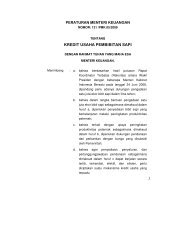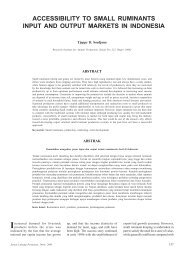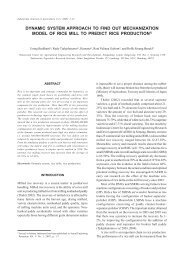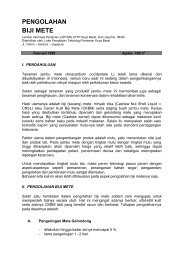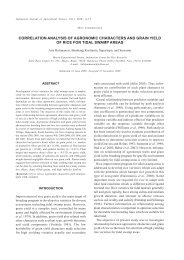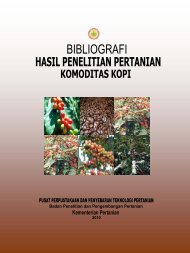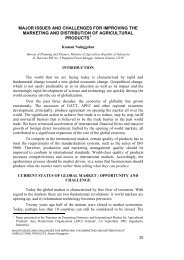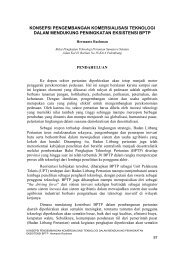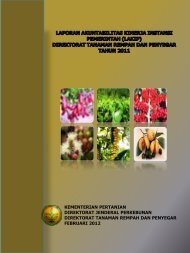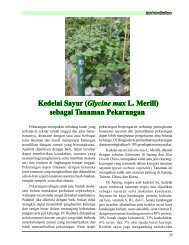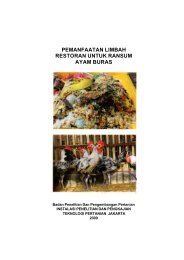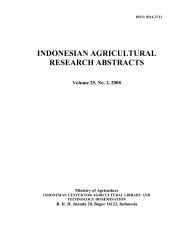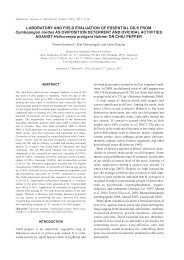Agro-SocioeconomicNewsletter - Pusat Sosial Ekonomi dan ...
Agro-SocioeconomicNewsletter - Pusat Sosial Ekonomi dan ...
Agro-SocioeconomicNewsletter - Pusat Sosial Ekonomi dan ...
- No tags were found...
Create successful ePaper yourself
Turn your PDF publications into a flip-book with our unique Google optimized e-Paper software.
Vol. 01 No. 1 February 2007 Page 3With this scenario, theamount of subsidizedfertilizers is around Rp. 5.8billion and the total volumeof subsidized fertilizersprovided by the governmentis 6.307.441 tons or about6.3 million tons which couldbe broken down as follows:Urea 4.509.650 tons or 4.5million tons, SP-36 753.285tons or about 753 thousandtons, ZA 629.894 tons or around 630 thousand tons, and NPK414.612 tons or more or less 415 thousand tons.The distribution system of fertilizers applied currently issuggested to change, from passive and incomplete distributionsystem to active and complete distribution system. This impliesthat the new system will be dealing with a number of weaknessescarried out at the moment, such as: vulnerable manipulation ofsubsidy magnitude at retailer/kiosk level, out of the target, notable to compete with price dualism, and farmers have tendency toapply fertilizers beyond the recommended amount (overintensification).Policy ImplicationsTo avoid ineffectiveness of fertilizer’s HET in 2007, the HETshould be increased because fertilizer’s HET during the last 3(three) years had never been adjusted to the current condition,making it reasonable to increase. The current unrealisticfertilizer’s HET is simply based on the fact that the price of fuelduring the last three years have been increasing several times,while the price of fertilizers where transportation is one of themain cost had never been increased. If the budget for subsidizedfertilizers and the government buying price (HPP) for fertilizers isunchanged, the total volume of subsidized fertilizers is expectedto increase with the increase of fertilizer’s HET. Interesting toknow that the main reason of ineffective fertilizer’s HET is causedby the available volume of subsidized fertilizers is less than thevolume required by the farmers. Moreover, the applied fertilizer’sHET is no longer realistic. In this context, the increasepercentage of fertilizer’s HET should consider the capability offarmers to meet the price. Based on this research finding, theaverage increase of HET for the four types of fertilizers (Urea,SP-36, ZA, and NPK) should no more than12.13%.Since the increase of fertilizer’s HET is surelyreduce paddy farm profit, the governmentshould balance the negative impact caused bythe situation by, at the same time, increasingthe government buying rate (HPP) for paddy atthe same or different rate of percentage as inthe fertilizers. In this connection, thegovernment has an obligation to guarantee theeffectiveness of the paddy’s HPP. If this policyis taken by the government as the permanentprocedure whenever the rate of fertilizer’s HETincrease, the negative impact related to economic, social andpolitical dimensions should be easily encountered. However, it isimportant to note that with this scenario, the government is in noabsolute conduct at any time to freely increase fertilizer’s HET.The percentage increase of fertilizer’s HET should alwaysconsider the capability of farmers to cope with such increase.To ensure the effectiveness of fertilizer’s HET in 2007, the onethat has been increased at farmers’ level, the government has toreplace the current passive and incomplete distribution system offertilizers with that of active and complete one. One of theconsequences of the current passive and incomplete distributionsystem is that the distribution would be out of the target.Therefore, the advantage of the increased fertilizer’s HET wouldpractically enjoyed only by the actors of distribution if noimprovement made to the current fertilizer’s distribution system.In fact, from the government point of view, the target of suchsubsidized fertilizers should be in favor of the farmer, that is toreduce the cost of production and to gain more profit from theirfarm activities.Correspondence: Nizwar Syafa’at (nizwars@yahoo.com)ANALYSIS OF NOTIFICATIONS ANDMODALITY FRAMEWORKS OF THEAGRICULTURE AGREEMENT IN THE WTOBackgroundWTO was formed and started with the aim toward a strong,connected and a sustainable multilateral trading system amongmember countries. The WTO has formulated and produced eithertrade agreements or disagreements, on each round of it’s’negotiations. Related to agriculture, the agreement was called anagreement of agriculture (AoA). AoA was viewed among membercountries as the key issue, and considered to be on the fronttrack of all negotiations. AoA covers three main pillars of issues,namely: (1) domesticsupport, (2) export subsidy,and (3) market access.Those three issues wereintensivelybeingnegotiated and insistedupon by the developingcountries to reach a newtrade deal, through themechanism of special anddifferential treatment.Since the last round ofnegotiations (the UruguayRound) and ten years has passed by, neither significant changenor balanced agreement on agriculture was adopted.Nevertheless, the year OF 2013, was the time-limit agreed bymember countries for modality in the export subsidy’ issue.For Indonesia, it is extremely important to gather and examine allinformation to justify each round of talks. It is also important toanticipate and analyze each of proposals by other countries.Indonesia, being the coordinator of G-33, is also need to prepareits position on the negotiations and anticipatethe impact of various international andmultilateral policies and agreements into its owndomestic agricultural commodities andresources. It also felt the need to look intoimpact of each round of talks/negotiations toother developing countries.Proposal for modalities on each of the threepillars will always be emerged for round oftalks/negotiations. It is important, for Indonesiato analyze and to anticipate the impact of thoseproposals to agricultural development.ICASEPS is interested in studying notificationsand modality frameworks of the AoA in the WTO. Its impact onoverall G-33 countries is also important to be analyzed.Objectivesa. To re-assess proposals on the domestic support cut and toanalyze each impact on agricultural performance, farmers’livelihoods in Indonesia and G-33,b. To examine proposals on the modality on export subsidies andto analyze each impact on agricultural performance, farmers’livelihoods in Indonesia and G-33,c. To analyze proposals of each scheme of tariff cuts that are onthe table recently and identify its impact on agriculturalperformance, farmers’ livelihoods in Indonesia and G-33,



